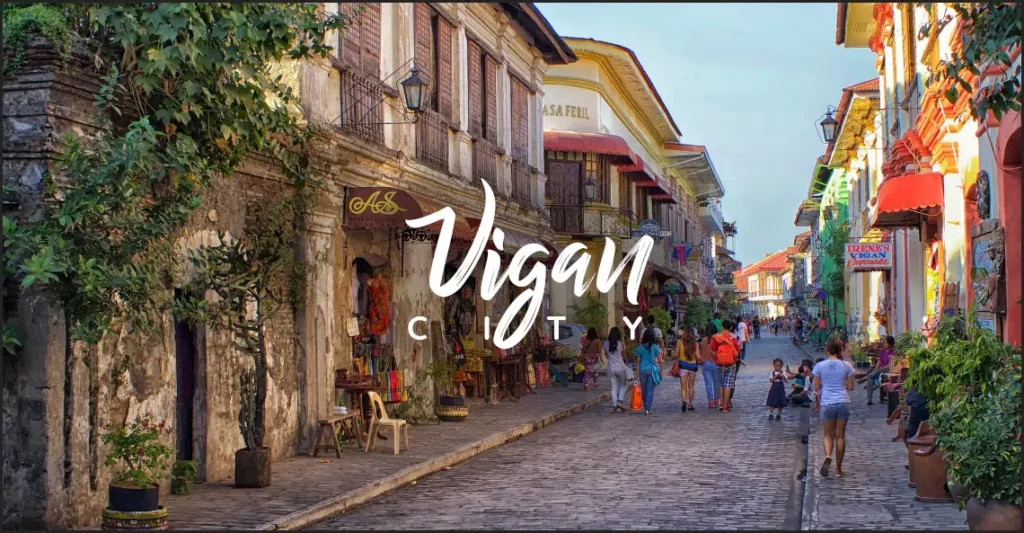Step into the picturesque town of Vigan, and you’ll find yourself transported to a bygone era. Nestled in the northern part of the Philippines, Vigan is a UNESCO World Heritage Site and a living testament to the country’s colonial past. Its cobblestone streets, ancestral houses, and well-preserved Spanish colonial architecture tell a tale of history and heritage that captivates every visitor. In this blog post, we embark on a journey through the charming streets of Vigan, exploring the enchanting places that make it a treasure trove of Filipino culture and history.
Calle Crisologo – A Walk Back in Time
The heart of Vigan’s historic district is Calle Crisologo, a cobblestone street lined with ancestral houses dating back to the Spanish colonial era. Also, horse-drawn carriages, known as kalesa, leisurely traverse the street, adding to the nostalgic ambiance. As you stroll along Calle Crisologo, the centuries-old houses, with their massive wooden doors, capiz shell windows, and balconies, transport you to a bygone era, offering a glimpse of what life was like during the Spanish colonial period.
Plaza Burgos and Plaza Salcedo – Gathering Places of the Past
Plaza Burgos and Plaza Salcedo are two historic squares that serve as gathering places in Vigan. Also, Plaza Burgos, named after the Filipino martyr Padre Jose Burgos, is a favorite spot for locals and visitors to relax and unwind. It features a prominent monument of Padre Burgos, a picturesque fountain, and lush greenery.
Plaza Salcedo, named after the Spanish conquistador Juan de Salcedo, is another charming square surrounded by heritage buildings. It is dominated by a statue of Juan de Salcedo, standing proudly in the center. Both plazas are perfect spots to take a leisurely break and immerse yourself in the town’s historical ambiance.
Baluarte – A Wildlife Sanctuary with a View
For a unique experience, head to Baluarte, a zoological park and wildlife sanctuary situated on a hill overlooking Vigan. Owned by former Ilocos Sur Governor Luis “Chavit” Singson, Baluarte features a diverse collection of animals, from exotic birds and reptiles to exotic species like tigers and zebras. Visitors can take a safari-like tour, interact with some animals, and enjoy panoramic views of the surrounding landscape.
Bantay Church and Bell Tower – A Historic Landmark

Located just a few kilometers from Vigan, the Bantay Church, and Bell Tower offer a glimpse into the region’s religious heritage. The church, officially known as St. Augustine Parish Church, is a striking example of Baroque architecture, characterized by its massive brick facade and intricate details. The adjacent bell tower, locally known as Bantay Belfry, stands tall and proud, providing a commanding view of the surrounding countryside.
Hidden Gardens – A Culinary and Horticultural Delight

Hidden Gardens is a charming restaurant and horticultural center that celebrates Filipino cuisine and local flora. Amid lush gardens, visitors can indulge in traditional Filipino dishes served in an alfresco setting. The restaurant also offers workshops on traditional crafts and gardening, providing insights into Filipino culture and heritage.
Strolling Down Calle Crisologo:

One of the highlights of any visit to Vigan is a stroll down Calle Crisologo, a charming street lined with ancestral houses. also, the cobblestone pavement and well-preserved buildings take visitors back in time to the Spanish colonial era. These houses, built with thick walls and large wooden doors, are a testament to the wealth and grandeur of the families who once resided there. As the sun sets, the street comes alive with the warm glow of vintage lamps, creating an atmosphere that transports visitors to a bygone era.
Cultural Immersion

Apart from its architectural wonders, Vigan offers a plethora of opportunities to immerse oneself in the local culture. Visitors can explore the Syquia Mansion, the former residence of the country’s sixth president, Elpidio Quirino, which now serves as a museum. The museum houses an extensive collection of historical artifacts, paintings, and memorabilia, providing valuable insights into the nation’s past.
The city’s vibrant street market, known as the Vigan Public Market, is a great place to experience the local way of life. Here, you can find a wide array of handicrafts, woven products, and traditional delicacies that make perfect souvenirs to take home.
No visit to Vigan would be complete without savoring its unique culinary offerings. Further, Vigan is famous for its traditional dishes, with “Empanada” taking center stage. This savory pastry is filled with a mixture of ground pork, green papaya, and various spices before being deep-fried to perfection. Another must-try delicacy is “Vigan Longganisa,” a garlicky and slightly sour pork sausage that will leave your taste buds begging for more.
Preserving the Past for the Future:

Vigan’s recognition as a UNESCO World Heritage Site has played a vital role in preserving its cultural and architectural heritage. The local government and residents have taken great care to protect the city’s unique charm, ensuring that future generations can experience the beauty and history it has to offer.
Conclusion
Vigan is a city that seamlessly blends the past and present, a place where history and heritage are lovingly preserved. Also, from the cobblestone streets of Calle Crisologo to the tranquil plazas of Plaza Burgos and Plaza Salcedo, every corner of Vigan is steeped in stories of the past.
As you explore Vigan’s enchanting places, you’ll be transported to a time when horse-drawn carriages roamed the streets, and ancestral houses stood as proud witnesses to history. Vigan is a true gem of Filipino culture, a living museum that immerses you in the country’s colonial past and rich traditions.
So, come and experience the timeless charm of Vigan. Walk the cobbled streets, marvel at the ancestral houses, and embrace the historical beauty that awaits you. Moreover, Vigan’s enchanting places will leave an indelible mark on your heart, making it a journey through time that you will cherish forever.





